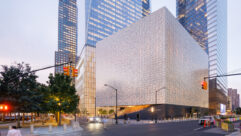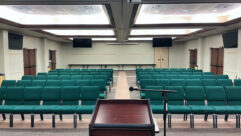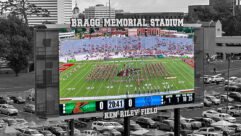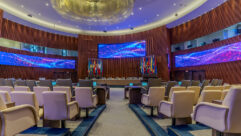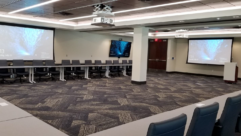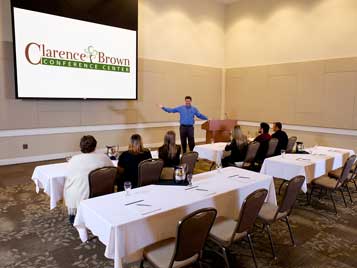

A major conference center with multiple venues had to upgrade its analog AV systems with new digital connectivity and they called in AGT to make the change. CEO Mark Cray is here to tell us what they needed and how AGT met the challenge with Crestron DigitalMedia and AirMedia. That’s coming right up on the SVC Podcast.
Mark, thanks for being with us on the SVC Podcast from Applied Global Technologies better known as AGT and I believe you’re headquartered in Kennesaw, Georgia?
I’m actually out of our Cocoa, Florida location. We’re headquartered up in Kennesaw and we’ve got an office in the Space Coast of Florida, which is where I’m at. [Timestamp: 1:06]
Wonderful area. I haven’t been there in a long while but we’re going to be going back there very soon.
It’s a lovely place to visit.
Before we get into the Clarence Brown Conference Center project, tell us about AGT and what goes on there.
AGT has been in business for a little over 20 years now, and we work with all different types of businesses. So we work with large multinational Fortune 1000-type businesses. We work with state governments, federal governments, universities. We also work with small businesses, so any type of business we work with. And then we just take on projects – training rooms, boardrooms, conference rooms. We do special things like video operations centers and command centers in the government, even the small huddle rooms which are really popular now. So really any type of multimedia/visual collaboration/AV type project we tackle. We stay away from the residential stuff, but really anything in the business space. [Timestamp: 2:03]
And the Clarence Brown Conference Center where the project was done is located about half way between Atlanta and Chattanooga.
Yep; Cartersville, Georgia there.
Yeah and right off of Interstate 75 and it seems to be a busy place, pretty high profile.
Yeah. They did something really interesting there. They built, I think like a 40,000 square foot facility and they have all types of gatherings, whether they’re social gatherings or business gatherings; so anything from meetings and tradeshows and training expos all the way to just weddings and special events. So really any type of personal or business meeting they can accommodate. [Timestamp: 2:37]
All right. And they called in AGT so what did they need from this? They already had an AV system in place, I understand but they needed it upgraded or updated?
Yeah. There was a couple of things they needed. One thing from a technology standpoint, they were due for a refresh so they had the equipment installed many years before and they were really in need of a refresh to be able to upgrade from analog to digital. Also just kind of a tech refresh on some of the other components. And they also really kind of were experiencing a lot of usability issues, so they really didn’t have the best design from their original provider and they had a lot of user issues. The system wasn’t very reliable and they weren’t getting good maintenance support. So it was a combination of new design, new interfaces and just some good support from a service provider. [Timestamp: 3:28]
And I guess they were getting fewer and fewer clients coming in with VGA connections on their equipment.
The HTMI was definitely becoming a big requirement for them.
And you decided to go with the Crestron DigitalMedia and AirMedia. Was that just a good fit for this one or are your people just familiar with those systems?
Well we’re familiar definitely with the Crestron, but we also, of course, represent all the other kind of major manufacturers so we kind of looked at their scenario. We noticed that they had a lot of Crestron control processors already. They already had some Crestron touch panels, so they were familiar with Crestron. So we thought it was a good fit from that perspective; we could leverage some of what they already had. And Crestron DigitalMedia and AirMedia we think are really good products that kind of future-proofed them. So they were in need of an upgrade, you know, the solutions really fit their requirements today, but they also support things like 4K and other things that we thought would be good to give a lot of mileage to Clarence Brown. [Timestamp: 4:25]
And this is no small place. They’ve got a lot of different venues in there. So let’s just take them one by one because you did something in all of these places. Carter Hall for instance. What did you do in there?
Yeah. Carter Hall is a 300-seat auditorium with a main projector and a screen and then two podiums. So we redid all the AV components and put the digital media in there. We put a new projector in there. We put a new touch panel system in there, refreshed the AV so it was really kind of a complete overhaul for them. We got a control panel in the back in a control room that’s where their technicians kind of can change things and operate things for the speaker. [Timestamp: 5:08]
That seems to be one of the balancing acts you have to do with these systems. How much do you put in the users’ hands and how much do you keep protected in the back room just for the tech people?
Yeah, yeah. That is definitely a tight rope to balance.
Okay, that was Carter Hall where they have a lot of assemblies and so forth where you can get a big group of people together. What happened in Stilesboro Hall?
Stilesboro Hall is a 3,000 square foot facility that actually can be divided up into three spaces. So we could operate it as a single space with three different projectors and projection screens or it can be divided up as three individual rooms or multiple combinations thereof. So we upgraded the AV system. We put in new projectors. We gave them three touch panels for each of the rooms to control as well as a master touch panel in the back room. Then we also did a lot with their audio. We also did a lot to automate it. If you go into the room and select Mode 1 or Mode 2 or Mode 3, the system does a lot of the automatic configuration for them so they don’t have to think about what components are in use or not in use. The program kind of takes care of that thought process for them. [Timestamp: 6:21]
Yeah, when you get into a situation where the room is differently configurable, you can pull back partitions and make it a bigger room and change the seating, things can get creative particularly in the way you do the sound.
Yeah, yeah. They can get really complicated there.
And then you moved on to the Etowah Ballroom. That looks like a very spacious place. What did you have to do in there?
Yeah, that was probably the toughest room to tackle. The Etowah Ballroom is a 13,000 square foot facility they can break up into four total spaces. So the way we designed it is there’s actually 12 different physical and technical room configurations that that room can go into. It’s not five screens and eight podiums. Each podium has its own wireless touch panel plus there’s a master touch panel in the control room. So we did all the – kind of the guts and the internal system, the audio system, and then redid all the screens and put in new floor boxes that would support the digital and then again, kind of design a really smart and intuitive interface that can understand all the complexities of the different configurations. [Timestamp: 7:33]
Probably all the really high profile events happen in there but you had another place, not necessarily a big venue but one where you can really make or break it and that’s in the Executive Boardroom. You’ve got some very big executive people who don’t want to look dumb trying to operate the AV system.
Yeah. You kind of alluded to that. I was going to say that even though in its design it was probably the most simple room to design and implement, it was the one that we focused the most on because like you said, if the executives look bad you definitely hear about it. The first part of it that we did was, of course, put in a new Crestron control panel. We also changed out the AV system and integrated with a Polycon video conferencing system. We made sure that we kept that into play. So we just really kind of simplified the user interface as best as we could to make it very user friendly and straight forward, and then of course focused on just making sure that the room is aesthetically really nice looking. [Timestamp: 8:32]
Well, that’s always a big job and you never know exactly what the user experience level is going to be with the guys at the top. I guess you have to make it very user friendly with all of the very technical stuff just going on behind the scenes.
That’s right. Yeah, we learned many years ago obviously that the system can have a lot of capabilities, but the key thing is what is it that users are going to do with it and kind of design the system to make it as simple a possible. [Timestamp: 9:00]
Well, this has been great listening to what you did in the various parts of the Clarence Brown Conference Center and in Part 2 we’ll get more into the mechanics of how you did all of that. So we’ll hear about that. Mark Cray with AGT and the upgrade for the Clarence Brown Conference Center in Cartersville, Georgia.
Thanks, Bennett.
Thank you for being here with us for the SVC Podcast with Mark Cray of AGT. Show notes are available on the website of Sound & Video Contractor at svconline.com. In Part 2 Mark will get into the details of how AGT made the digital upgrade happen. Be with us for that one next time on the SVC Podcast.


